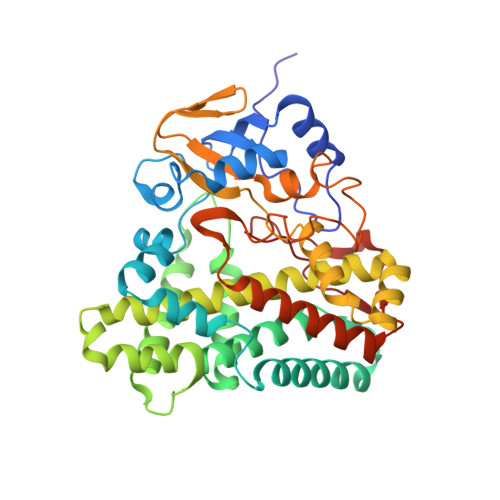A new strategy for hit generation: Novel in cellulo active inhibitors of CYP121A1 from Mycobacterium tuberculosis via a combined X-ray crystallographic and phenotypic screening approach (XP screen).
Frederickson, M., Selvam, I.R., Evangelopoulos, D., McLean, K.J., Katariya, M.M., Tunnicliffe, R.B., Campbell, B., Kavanagh, M.E., Charoensutthivarakul, S., Blankley, R.T., Levy, C.W., de Carvalho, L.P.S., Leys, D., Munro, A.W., Coyne, A.G., Abell, C.(2022) Eur J Med Chem 230: 114105-114105
- PubMed: 35065413
- DOI: https://doi.org/10.1016/j.ejmech.2022.114105
- Primary Citation of Related Structures:
7NQM, 7NQN, 7NQO - PubMed Abstract:
There is a pressing need for new drugs against tuberculosis (TB) to combat the growing resistance to current antituberculars. Herein a novel strategy is described for hit generation against promising TB targets involving X-ray crystallographic screening in combination with phenotypic screening. This combined approach (XP Screen) affords both a validation of target engagement as well as determination of in cellulo activity. The utility of this method is illustrated by way of an XP Screen against CYP121A1, a cytochrome P450 enzyme from Mycobacterium tuberculosis (Mtb) championed as a validated drug discovery target. A focused screening set was synthesized and tested by such means, with several members of the set showing promising activity against Mtb strain H37Rv. One compound was observed as an X-ray hit against CYP121A1 and showed improved activity against Mtb strain H37Rv under multiple assay conditions (pan-assay activity). Data obtained during X-ray crystallographic screening were utilized in a structure-based campaign to design a limited number of analogues (less than twenty), many of which also showed pan-assay activity against Mtb strain H37Rv. These included the benzo[b][1,4]oxazine derivative (MIC 90 6.25?¦̀M), a novel hit compound suitable as a starting point for a more involved hit to lead candidate medicinal chemistry campaign.
Organizational Affiliation:
Yusuf Hamied Department of Chemistry, University of Cambridge, Lensfield Road, Cambridge, CB2 1EW, United Kingdom.





















